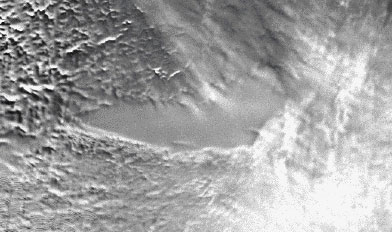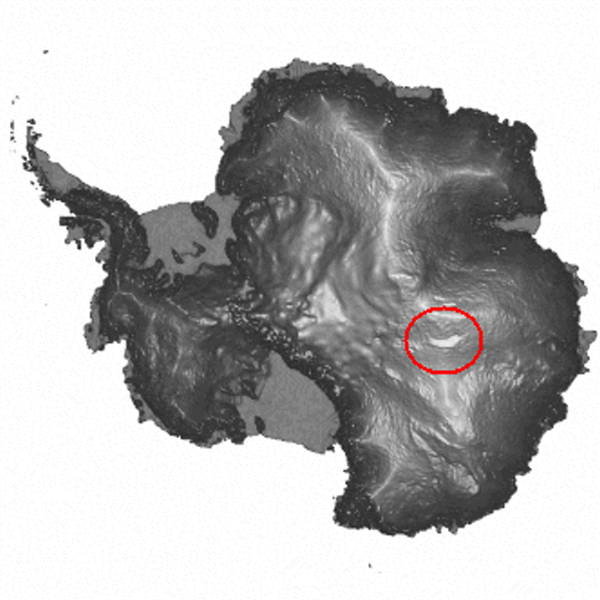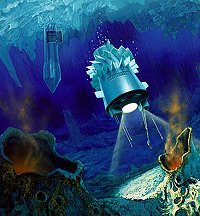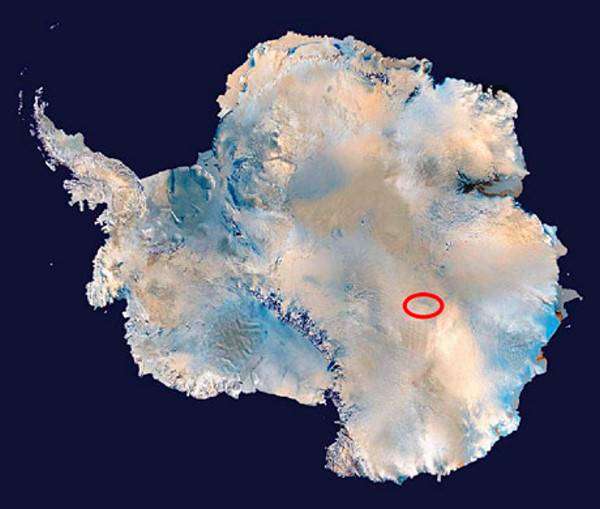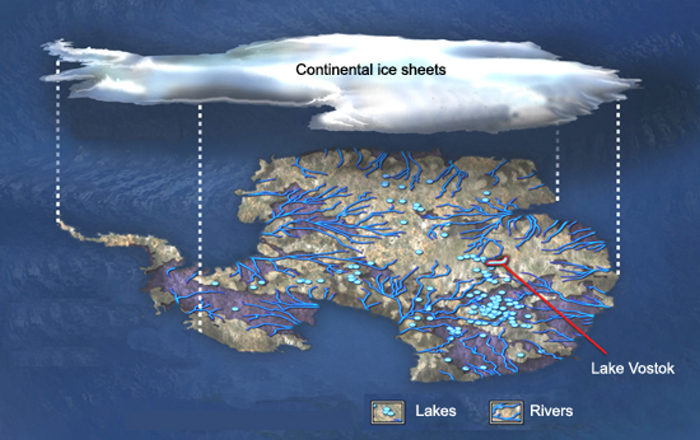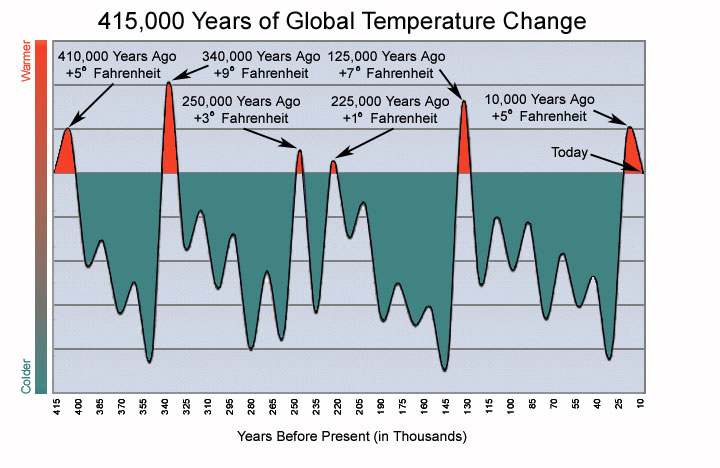|
|
|||
|
77° 0' 0" S, 105° 0' 0" E ..
RADARSAT image of the surface of the Antarctic ice sheet above Lake Vostok. Credit: NASA Goddard Space Flight Lake
Vostok
When imaged from space by radar, Lake Vostok can be seen as a flat area within the ice sheet. (NASAGSFC) Lake Vostok is the largest of more than 140 subglacial lakes found under the surface of Antarctica. It is located beneath Russia's Vostok Station, 4,000 metres (13,000 ft) under the surface of the central East Antarctic ice sheet. It is 250 kilometres (160 mi) long by 50 kilometres (31 mi) wide at its widest point, thus similar in size to Lake Ontario, and is divided into two deep basins by a ridge. The water over the ridge is about 200 metres (660 ft), compared to roughly 400 metres (1,300 ft) deep in the northern basin and 800 metres (2,600 ft) deep in the southern. Lake Vostok covers an area of 15,690 square kilometres (6,060 sq mi). It has an estimated volume of 5,400 cubic kilometres (1,300 cu mi) and consists of fresh water. The average depth is 344 metres (1,129 ft). In May 2005 an island was found in the center of the lake.
Contents
Discovery
Airborne ice-penetrating radar data first showed lakes beneath the Antarctic ice-sheet in the late 1960s and early 1970s. The existence of Lake Vostok was first noted in 1973 by scientists of the Scott Polar Research Institute, but not named by them.[1] Russian and British scientists delineated the lake in 1996 by integrating a variety of data, including airborne ice-penetrating radar imaging observations and spaceborne radar altimetry. It has been confirmed that the lake contains large amounts of liquid water under the more than three-kilometer thick icecap, promising to be the most unspoiled lake on Earth. The lake has at least 22 cavities of liquid water, averaging 10km each.[2] The lake water is undoubtedly very old. Initially, it was thought that the same water had made up the lake since the time of its formation, giving a residence time in the order of one million years.[3] Later research by Robin Bell and Michael Studinger from the Lamont-Doherty Earth Observatory of Columbia University suggested that the water of the lake is continually freezing and being carried away by the motion of the Antarctic ice sheet, while being replaced by water melting from other parts of the ice sheet in these high pressure conditions. This resulted in an estimate that the entire volume of the lake is frozen and removed every 13,300 years—its effective mean residence time.[4] In comparison, the similarly sized Lake Ontario has a residence time of six years, which is typical for a lake of that size. The average water temperature is around -3 °C (27 °F); it remains liquid below the normal freezing point because of high pressure from the weight of the ice above it. Geothermal heat from the Earth's interior warms the bottom of the lake. The ice sheet itself insulates the lake from cold temperatures on the surface. Researchers working at Vostok Station produced one of the world's longest ice cores in 1998. A joint Russian, French, and U.S. team drilled and analyzed the core, which is 3,623 metres (11,886 ft) long. Ice samples from cores drilled close to the top of the lake have been analyzed to be as old as 420,000 years, suggesting that the lake has been sealed under the icecap for between 500,000 and more than a million years. Drilling of the core was deliberately halted roughly 100 metres (300 ft)[5] above the suspected boundary where the ice sheet and the liquid waters of the lake are thought to meet. This was to prevent contamination of the lake from the 60 ton column of freon and aviation fuel Russian scientists filled it with to prevent it from freezing over. From this core, specifically from ice that is thought to have formed from lake water freezing onto the base of the ice sheet, evidence has been found, in the form of microbes, to suggest that the lake water supports life. Scientists suggested that the lake could possess a unique habitat for ancient bacteria with an isolated microbial gene pool containing characteristics developed perhaps 500,000 years ago.[6] Since Lake Vostok consists of two separate basins divided by a ridge, it has been suggested that the chemical and biological compositions of these two ecosystems are likely to be different. Lake Vostok is an oligotrophic extreme environment, one that is supersaturated with oxygen, with oxygen levels 50 times higher than those typically found in ordinary freshwater lakes on Earth. The sheer weight of the continental icecap sitting on top of Lake Vostok is believed to contribute to the high oxygen concentration. Besides dissolving in the water, oxygen and other gases are trapped in a type of structure called a clathrate. In clathrate structures, gases are enclosed in an icy cage and look like packed snow. These structures form at the high-pressure depths of Lake Vostok and would become unstable if brought to the surface.[3] Due to this high-pressure extreme environment, if water were to be released from Lake Vostok (from drilling, for example), it could gush like a popped carbonated drink can and, if not contained, open the lake to possible contamination and pose a potential hazard to scientists. Life
Microorganisms have been found in ice core drillings, but they are extant surface dwelling species. Since the ice core drilling stopped before they reached the water, to limit contamination, it is postulated that lower down there still may be unique microorganisms still to be found.[7] Due to the lake's similarity to the Jupiter moon Europa and Saturn's moon Enceladus, any confirmation of life living in Lake Vostok would strengthen the prospect for the possible presence of life on Europa or Enceladus.[8] In April 2005, German, Russian, and Japaneseresearchers found that the lake has tides. Depending on the position of the Sun and the Moon, the surface of the lake rises between 1 and 2 cm. The researchers assume that the fluctuation of the lake surface has a pumping effect that keeps the water circulating, which would promote the productivity of microorganisms if there are any. To probe the waters of Lake Vostok for life, without contamination, plans were initiated in 2001 by the Jet Propulsion Laboratory to start with a melter probe — the so-called "cryobot" — which melts down through the ice over Lake Vostok, unspooling a communications and power cable as it goes. The cryobot carries with it a small submersible, called a "hydrobot", which is deployed when the cryobot has melted to the ice-water interface. The hydrobot then swims off and "looks for life" with a camera and other instruments.[9][10] In January 2006, Robin Bell and Michael Studinger, Geophysical researchers from Columbia University, announced in Geophysical Research Letters the discovery of two smaller lakes under the icecap, named 90 Degrees East and Sovetskaya. In early 2010 the head of the Russian Antarctic Expedition, Valery Lukin, announced that a team of Russian scientists had only 100 meters of ice left to drill in order to reach the water. According to Lukin, new equipment had been developed by researchers at the St. Petersburg Nuclear Physics Institute that would ensure the lake remains uncontaminated upon intrusion. The scientists expect to reach the lake in 2010-2011.[11] It is suspected that the Antarctic subglacial lakes may be connected by a network of subterranean rivers. CPOM glaciologists Duncan Wingham (University College, London) and Martin Siegert (University of Bristol, now University of Edinburgh) published in Nature in 2006 that many of the subglacial lakes of Antarctica are at least temporarily interconnected. Because of varying water pressure in individual lakes, large, sub-surface rivers may suddenly form and then force large amounts of water through the solid ice.[3] Speculation on possible life and comparisons to Europa
The cryobot ice submersible, bound for Jupiter's moon, Europa, which scientists would like to test in Lake Vostok No other natural lake environment on Earth has this much oxygen. Any organisms in Lake Vostok must be capable of overcoming very high oxygen stress. Some have speculated that such organisms may have had to evolve special adaptations, such as high concentrations of protective enzymes, in order to survive the lake's oxygen-rich environment. Due to the lake's similarity to a moon of Jupiter, Europa, confirmation that life can survive in Lake Vostok might strengthen the argument for the presence of life on Europa. SOURCE: Wikipedia Lake Vostok
|
|||
|
..
"Lake Vostok is the holy grail," says John Priscu, one of America's leading Antarctica researchers. His Russian counterpart, Valery Lukin, agrees. The U. S. made the first flight to the moon, he told a reporter last year. Russia will be the first to Vostok. The Russian team first began drilling toward the buried Antarctic lake, which has been trapped deep beneath glacial ice for twenty-five million years, three decades ago. They worked meticulously, corkscrewing up pristine ice cores whose gases tell the atmospheric history of our planet. With each turn they got closer to the freshwater, closer to what many believe could be life-forms never seen on earth, perhaps similar to those NASA hopes to find buried on Jupiter's moon Europa. By 1998, the Russians managed to reach down about two miles, drilling to within a few hundred feet of the lake's surface. And then they stopped. They stopped as a courtesy to their scientific peers, who worried about what lay below the ice and what might happen if the antiquated Russian drills disturbed it. The Russians know that if they penetrate Lake Vostok, the lubricants and antifreeze present in their borehole will taint the scientific findings, and that the immense pressure the lake is under could spark an explosive geyser that reaches thousands of feet into the sky. But the Russians are no longer deterred. They've waited long enough and have decided that the risks are worth taking. The drill is achingly close. Soon, probably this winter, it will break through, deflowering our planet's last virgin ecosystem. — Luke Dittrich SOURCE: Esquire Magazine |
|||
|
..
June 23, 2008
"Lake Vostok is an international treasure. We have to convince not just the scientific community but the entire world that we can do this without contaminating the lake."At the very edge of the Antarctic ice horizon — is a scattering of snow-drifted buildings and radio towers known as Vostok Station--a Russian scientific outpost on the ice above ancient Lake Vostok that researchers have manned almost continuously for 40 years. Because of the long isolation, it's believed that Lake Vostok could contain new lifeforms, and unique geochemical processes. For five years, scientists in Russia and the United States have sought to probe the ancient lake to discover the secrets lying inside this pristine body of water. The overlying ice provides a continuous paleo-climatic record of 400,000 years, although the lake water itself may have been isolated for as long as 15 million years. Russian researchers have thawed ice estimated to be perhaps a million years old or more from above Lake Vostok, approximately 250 km long and 50 km wide, is an ancient lake that lies hidden more than two miles beneath the frozen surface of Antarctica. Scientists are using novel genomic techniques to determine how tiny, living "time capsules" survived the ages in total darkness, in freezing cold, and without food and energy from the sun. A major issue is the reality that it is impossible to penetrate an isolated ecosystem without contaminating it. The catch 22 inherent in Lake Vostok is that the very thing that make it potentially unique: because of its millennia of isolation from the rest of the world, it cannot be explored without introduction of microbes from the outer world. Antarcticlakes_vostok_3 NASA has expressed interest in exploring the lake to search for microbes that might be similar to ones on other planets. How the bacteria get energy to survive is an important unanswered question. The lake could be an analog to Jupiter's moon Europa or subsurface where conditions are similar. The ice segments were cut from an 11,866-foot ice core drilled in 1998 through a joint effort involving the United States, Russia, and France. The core was taken from approximately two miles below the surface of Antarctica and 656 feet (200 meters) above the surface of the lake, and has since been stored at -35 degrees Celsius at the National Ice Core Laboratory, Denver, Colo. "This lake may have been isolated for that long - 15 million years," said Lanoil, the principal investigator of the research project. "After nearly a year of preparation and verifying protocols, we are now ready to process the samples, and will examine the DNA of these microorganisms to understand how they survived in such an extreme environment." The original Russian Vostok station sits over the south end of the lake at the precise geomagnetic South Pole, surrounded by decades' worth of discarded machinery, waste and rubbish.
Over the years, the Russian scientists here have endured temperatures colder than parts of Mars, dwindling support and reflexive skepticism about the quality of their research from colleagues in Europe and the United States. Recent financial cutbacks in the Russian Antarctic Program mean that Vostok can be resupplied just once a year. Fuel and food are hauled overland by tractors about 900 miles from the coast. Mechanical breakdowns sometimes prevent the overland tractor trains from reaching Vostok. It was Russian scientists at Vostok Station who discovered the lake and who first realized its unique potential. Now they hope that the international effort to explore the life in the lake might benefit their own faltering research program. In the most ambitious drilling program ever undertaken on the southernmost continent, the Russian scientists produced the world's deepest ice core, containing an irreplaceable chemical record of more than 400,000 years of Earth's changing climate and atmosphere. They did not learn of the lake's existence or appreciate its importance until the project neared completion. But in 1998, as the drill reached within a hundred yards of the surface of the lake, they deliberately stopped. No one wanted to risk contaminating the water. To keep the ice hole from freezing shut as they worked, however, the Russian scientists over the years pumped it full of aviation fuel and Freon. Now there is too much drilling fluid to be safely pumped out of the hole, stored aboveground, recycled or removed, Russian officials have reported. At least 60 tons of the toxic chemicals sit in a narrow column that reaches to within a few hundred feet of the lake, like a needle poised above a bubble of expectations. It could be years before all the difficulties have been resolved and a project can be organized to explore the lake, and a decade before its pristine waters are breached, U.S. officials said. U.S. research communities within the Antarctic Circle are maintained by a government body--the United States Antarctic Program--that operates like a mini NASA. In our era of rapid climate change, it's important to realize that over 6 million cubic miles, about 70% of the planet's fresh water is locked in Antarctica's ice, about 90% of which is locked up in the apparently stable East Antarctic ice sheet, set on the rocky continental surface and partly hemmed in by mountains. Scattered in pockets between miles of ice and the rock foundation , are at least 145 lakes of unknown origin, connected by streams in an entire unseen hydrologic plumbing network, a system researchers believe that may affect the stability of the ice sheets. No other natural lake environment on Earth has this much oxygen as Lake Vostok -an oligotrophic extreme environment, one that is supersaturated with oxygen, with oxygen levels 50 times higher than those typically found in ordinary freshwater lakes. The sheer weight of the continental icecap sitting on top of Lake Vostok is believed to contribute to the high oxygen concentration. Microbial organisms in Lake Vostok must be capable of overcoming very high oxygen stress, and may have had to evolve special adaptations, such as high concentrations of protective enzymes, in order to survive. The discovery of interconnected lakes beneath kilometers of ice in Antarctica could be one of the most important scientific finds in recent years, but proper procedures need to be established before investigation begins, says Mahlon "Chuck" Kennicutt II, professor of oceanography at Texas A&M University and a leader in the research efforts. The National Science Foundation and 11 countries involved in the research and exploration are seeking agreement on how best to study these unique environments, which include at least 145 lakes under Antarctica's massive ice sheets. Participants in the project known as The Russian Antarctic Expedition have announced their intentions to penetrate Lake Vostok during coming Antarctic field seasons. "These lakes were rediscovered within the past 10 years or so, but no one yet has penetrated them and we want to make sure that the research is done properly and adheres to the highest environmental stewardship principles," says Kennicutt. "This has the potential to be one of the most important scientific discoveries in years, since sub-ice water appears to be an important player in many different processes fundamental to Antarctica and our planet. "We believe that these lakes are part of an interconnected system that spans the entire Antarctic continent," he adds. "These bodies of water are several miles beneath the ice sheet which took millions of years to form, meaning these lakes have been undisturbed and disconnected from our atmosphere for hundreds of thousands of years. It is highly likely that unique microbial communities that we never knew existed are lake residents." Scientists from the countries involved, which include the U.S., France, Italy, Japan, Russia, the United Kingdom and others, have concluded that lake entry and sampling will ultimately be necessary to accomplish the ambitious research objectives. "How to do this in the best way to preserve these environments and to be least invasive is a key question that needs further discussion," Kennicutt notes. "The countries involved have all agreed we must do as much as possible to avoid altering the lakes or causing any environmental damage." Research in Antarctica has always had a special set of rules among nations. It is the only continent on Earth that is managed through an international treaty signed by 45 countries representing two-thirds of the world's population. By unanimous consent of these nations, Antarctica has been viewed as a continent for science, research and peace. Scientists believe that the lakes exert an important control over the large ice-sheet movement, and that they exist as above-ground waterways do, with streams, rivers and lakes commonplace. Believed to span underneath the entirety of the continent that is 98% ice, they represent the chance to look back several million years. With millions of years separating them from our current atmosphere, Kennicutt believes that “…It is highly likely that unique microbial communities that we never knew existed are lake residents.” And while it is thought that it could take the US some 3-5 years to begin work itself on researching and studying the lakes, Kennicutt states that “…Once the U.S. becomes fully engaged in these research efforts, this will almost certainly be one of the dominant Antarctic research focus areas for at least the next decade, if not longer.” The largest subglacial lake, 12,000 feet beneath the surface ice is Lake Vostok, is a body of water the size of Lake Ontario and up to 2,600 feet deep. Researchers have mapped Lake Vostok with seismic studies and ice-penetrating radar but have not seen or reached it. Its burial below the ice cap predates the rise of humans, perhaps by several million years. No one knows if anything lives in the long-isolated lake--if not, it would be the first sterile water found on Earth. Any microbial life that does call Lake Vostok home would have to survive in a severely low-nutrient environment, without light, in near-freezing waters and at a pressure 360 times that of sea level. Lake Vostok an excellent Earth-bound staging-experiement for Europa, a moon of Jupiter believed to have ice-crusted oceans. Scientists believe Europa's ocean, which is warmed by gravitational forces, could be one of the best places in the Solar System to look for life. A craft sent to Europa would use nuclear power to melt through the 10km of ice that cover the moon's ocean. NASA and the Jet Propulsion Laboratory have designed a "cryobot," a robot, which would generate enough heat to melt the ice around it and slowly sink into the water. Once it reaches the lake, it would release a smaller swimming "hydrobot" to collect data for future exobiological surveys. This past January, a four-man science team led by British Antarctic Survey's (BAS) Dr Andy Smith has begun exploring ancient Lake Ellsworth hidden deep beneath Antarctica's ice sheet. As with Vostok, the lake could yield vital clues to life on Earth, climate change and future sea-level rise. Posted by Casey Kazan. Original Source: forbes.com/2008/06/19/lake-vostok-antarctica-tech-water SOURCE: Daily Galaxy |
|||
| FAIR USE NOTICE: This page contains copyrighted material the use of which has not been specifically authorized by the copyright owner. Pegasus Research Consortium distributes this material without profit to those who have expressed a prior interest in receiving the included information for research and educational purposes. We believe this constitutes a fair use of any such copyrighted material as provided for in 17 U.S.C § 107. If you wish to use copyrighted material from this site for purposes of your own that go beyond fair use, you must obtain permission from the copyright owner. | |||
|
|
